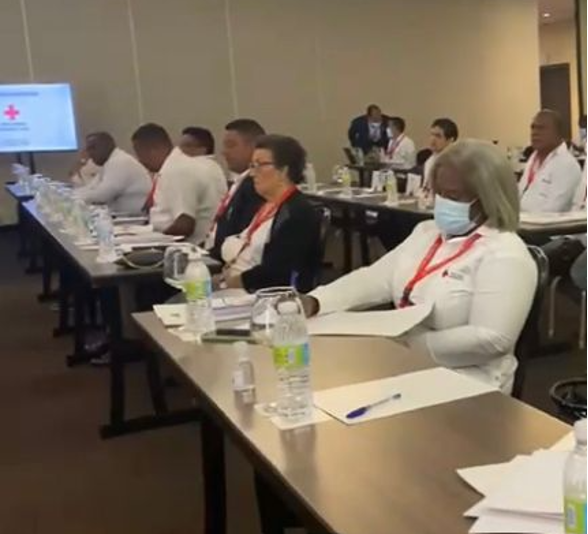
By 2021 the Legislative Advocacy Toolkit has been used to train 24 participants from the Dominican Red Cross across two workshops. This includes Presidents and Directors from branches of the National Society and 15 representatives of the National Technical Committee for Risk Prevention and Mitigation. This included: the Ministry of Public Health, the Ministry of Interior and Politics, Civil Defense, the National Council for Children and Adolescents (CONANI), Santo Domingo Water and Sewage Corporation (CAASD), the National Office of Seismic Evaluation and Vulnerability of Infrastructure and Buildings (ONESVIE), the Ministry of Education (MINERD), the National Institute of Hydraulic Resources (INDRHI) and the National Seismology Center (CNS-UASD).
This article shares the story of the community of Barrio Norte, Municipality and Province of Dajabón, in the Dominican Republic. Through the practical implementation of an advocacy strategy developed following the workshop, they managed a project to prevent flooding and promote the construction of a bridge.
Evangelista Rodriguez, President of the Dajabón Branch of the Dominican Red Cross, and Provincial President spoke with Rebeca Muñoz, IFRC’s Disaster Law Officer about the community advocacy strategy developed.
The project took place in the community known as Sector Barrio Norte, intersection of 27 de febrero street and Capotillo street, municipality, and province of Dajabón. Evangelista tells us about her experience:

What was the problem facing the community?
There were several; among them, the poor coordination for the cleaning, lack of a proper bridge and heavy showers generated flooding of homes and premises in the surrounding area. This affected the quality of life of about 500-1000 people living in the community.
What was the request made by the community?
The need to build a bridge so that the rainwater could flow properly and avoid affecting the houses and premises in the area.
What was the strategy and process applied? Which institutions were approached?
The Dominican Red Cross received a message from the local neighborhood council, which also included the community network, with whom they had previously had training on vulnerability analysis and response capacity.
The community, seeing the situation that affected them, had been empowered and decided to take action to improve their quality of life. As a result of this situation, the concern to work on the issue arose. All the parties involved (neighborhood council, community network, representation of the Catholic church, representation from the evangelical church) developed an advocacy strategy, inspired by the IFRC’s legislative advocacy toolkit. In turn, they coordinated a letter to present to the mayor and the council of aldermen of the city council.
It is important to mention that years before this process began, a bridge had been built, but it had not been properly constructed. After the first rains it collapsed and flooded the area again, affecting the communities.

What was the message sent to decision makers?
The streamlined coordination generated a message establishing the urgency of the construction of a bridge over the Mariología canal in Barrio Norte, located between the intersection of Capotillo Street and 27 de febrero Street, to avoid floods that led to the loss of household goods. The message was developed to be presented to the síndico/mayor of the Municipality of Dajabón, Mr. Santiago Riverón Arias.
What was the response from the decision makers? How long did the process take?
It was a three-month process. The Dominican Red Cross meet the mayor at an event, walking upstairs and at that moment he was approached, communicating a brief and succinct petition about the problem and the possible existing solutions according to the need of the community (the construction of a bridge).
How did the Dominican Red Cross (DRC) intervene to make a difference in this process?
The Dominican Red Cross, as a relief agency, is called every time an emergency occurs, such as the floods that occurred in this case. The DRC felt impotent because when floods occurred, they could only help in response, but not in prevention. Because of this, DRC worked on an advocacy strategy that would improve and preserve the lives of people and their belongings affected by the floods. During this process, DRC also gave talks on community capacity building, as well as on its mandate and principles.
Once the meeting with the mayor was formalized, the community invited DRC to a branch meeting. The president of the branch, explained to the mayor the importance of the work that DRC does at the local and provincial level, considering DRC’s work and experience in the communities. He also promoted the work of the DRC within the country's early warning system.
How did the community/DRC advocate for the construction of the bridge?
The organization of the community was achieved by coordinating the participation of the neighborhood council and its president, the president of the union of the mothers' center of the northern neighborhood, a representative of the Catholic church and the evangelical church, and the sector's councilwomen.
What were the results?
A bridge was built with the necessary specifications to prevent flooding in the community, in addition to the proper cleaning of the gully. The community helped in the physical construction of the bridge, contributing with labor (for example, the participation of masons from the community), and crime was reduced.
Is there anything you would like to highlight from this whole process?
The advocacy and the different community representatives that participated, together with the Dominican Red Cross, produced an important power to stress the local government to execute actions for the benefit of the community.


